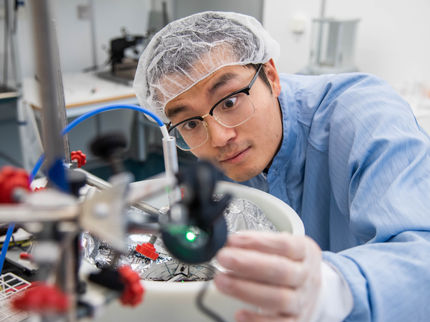Engineers: Weak laser can ignite nanoparticles, with exciting possibilities
Advertisement
University of Florida engineering researchers have found they can ignite certain nanoparticles using a low-power laser, a development they say opens the door to a wave of new technologies in health care, computing and automotive design.
A paper about the research appeared in Nature Nanotechnology.
Vijay Krishna, Nathanael Stevens, Ben Koopman and Brij Moudgil say they used lasers not much more intense than those found in laser pointers to light up, heat or ignite manufactured carbon molecules, known as fullerenes, whose soccer-ball-like shapes had been distorted in certain ways. They said the discovery suggests a score of important new applications for these so-called "functionalized fullerenes" molecules already being developed for a broad range of industries and commercial and medical products.
"The beauty of this is that it only requires a very low intensity laser," said Moudgil, professor of materials science and engineering and director of the engineering college's Particle Engineering Research Center, where the research was conducted.
The researchers used lasers with power in the range of 500 milliwatts. Though weak by laser standards, the researchers believe the lasers have enough energy to initiate the uncoiling or unraveling of the modified or functionalized fullerenes. That process, they believe, rapidly releases the energy stored when the molecules are formed into their unusual shapes, causing light, heat or burning under different conditions.
The Nature Nanotechnology paper says the researchers tested the technique in three possible applications.
In the first, they infused cancer cells in a laboratory with a variety of functionalized fullerenes known to be biologically safe called polyhydroxy fullerenes. They then used the laser to heat the fullerenes, destroying the cancer cells from within.
"It caused stress in the cells, and then after 10 seconds we just see the cells pop," said Krishna, a postdoctoral associate in the Particle Engineering Research Center.
He said the finding suggests doctors could dose patients with the polyhdroxy fullerenes, identify the location of cancers, then treat them using low-power lasers, leaving other tissues unharmed. Another application would be to image the locations of tumors or other areas of interest in the body using the fullerenes' capability to light up.
The paper also reports the researchers used fullerenes to ignite a small explosive charge. The weak laser contained far less energy than standard electrical explosive initiators, the researchers said, yet still ignited a type of functionalized fullerenes called carboxy fullerenes. That event in turn ignited comparatively powerful explosives used in traditional blasting caps.
Mining, tunneling or demolition crews currently run electrical lines to explosives, a time-consuming and expensive process for distant explosives. The experiment suggests crews could use blasting caps armed with the fullerenes and simply point a laser to set them off.
"Traditional bursting caps require a lot of energy to ignite — they use a hot tungsten filament," said Nathanael Stevens, a postdoctoral associate in the Particle Engineering Research Center. "So, it is interesting that we can do it with just a low-powered laser."
The researchers coated paper with polyhyroxy fullerenes, then used an ultrahigh resolution laser to write a miniature version of the letters "UF." The demonstration suggests the technique could be used for many applications that require extremely minute, precise, lithography. Moudgil said the researchers had developed one promising application involving creating the intricate patterns on computer chips.
Although not discussed in the paper, other potential applications include infusing the fullerenes in gasoline, then igniting them with lasers rather than traditional sparkplugs in car engines, Moudgil said. Because the process is likely to burn more of the gasoline entering the cylinders, it could make cars more efficient and less polluting.
The researchers have identified more than a dozen potential applications and applied for several patents. This Nature Nanotechnology paper is the first scientific publication on the discovery and the new technique.




























































